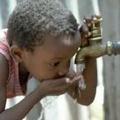 根據世界衛生組織(WHO)與聯合國兒童基金會(UNICEF)最新一份報告指出,世界曾承諾在2015年之前,減少無法取得純淨飲用水與基本衛生設施總人數的一半,不過現勢的發展卻離目標愈行愈遠。該報告警示,全球人口與都市化快速增長,使得窮人更難獲得充分服務與照顧;若不趕緊提升工作速度與投資,將無法在期限內達成許諾之目標。
根據世界衛生組織(WHO)與聯合國兒童基金會(UNICEF)最新一份報告指出,世界曾承諾在2015年之前,減少無法取得純淨飲用水與基本衛生設施總人數的一半,不過現勢的發展卻離目標愈行愈遠。該報告警示,全球人口與都市化快速增長,使得窮人更難獲得充分服務與照顧;若不趕緊提升工作速度與投資,將無法在期限內達成許諾之目標。
報告中指出,當前超過11億居住於都市及鄉間的人口無法提升飲用水的品質,並有26億人連最基本的公共衛生安全保障都付之闕如。
報告中提及,兒童特別容易感染與飲用水衛生息息相關的疾病,諸如痢疾及寄生蟲疾病等,是故因飲用水質造成的兒童健康問題特別常見。衛生設備的嚴重缺乏相對也增加了霍亂、傷寒和痢疾等疾病大爆發的可能性。世界衛生組織估計2005年有160萬未滿5歲的兒童死於不潔的飲用水及衛生條件不佳。
報告中指出,光是維持一定比例的都市居民得以取用潔淨的飲用水和合適的公共衛生條件,全世界可能就已用了大量力氣。當前,95%的城市居民得以獲得飲用潔淨的水資源,80%得以享受公共衛生服務,但是發展中國家都市的人口正在急劇增加中。估計約有80%缺乏飲用水源改善的民眾居住在撒哈拉沙漠周圍的非洲地區、東亞及南亞地區。根據報告,撒哈拉沙漠周圍的非洲地區仍舊是主要的關心焦點。
報告中對聯合國在2000年訂定的不切實際目標提出進一步的懷疑。2000年時,聯合國宣佈千禧年發展目標(MDG), 致力於在2015年以前將全球的貧窮及營養不良人數減半,並且大幅度削減嬰兒和母體遺傳的致死率,進而擴大推動醫療保健的管道及教育。
這份報告需要工業國家投資總產值的0.54%來支撐,也就是每100美元的收入提撥約50美分。但是過去世界富國的承諾因為財政赤字而導致這項計劃無法實現。根據最新的WHO/UNICEF報告,千禧年發展目標中提升用水品質和衛生的目標,是改善世上窮人的衛生健康及生活水準最有效的方式之一。
The world is unlikely to meet its pledge to cut in half the number of people who lack access to clean drinking water and basic sanitation by 2015, according to a new report by the World Health Organization (WHO) and UNICEF. The pledge will go unmet absent a dramatic increase in the pace of work and investment over the next decade, the report warns, as rapid urbanization and population growth are putting increased pressure on the provision of services and the health of the poor.
More than 1.1 billion people in both urban and rural areas currently lack access to drinking water from an improved source, the report found, and 2.6 billion people do not have access to even basic sanitation.
It notes that the health impacts can be seen particularly in children, who are at particular risk from water-related diseases such as diarrhoeal and parasitic diseases. Lack of sanitation also increases the risk of outbreaks of cholera, typhoid and dysentery.
WHO estimates that in 2005, 1.6 million children under age 5 died from the consequences of unsafe water and inadequate hygiene. The world may struggle just to simply maintain the proportion of urban dwellers who have access to an improved source of drinking water and adequate sanitation., the report said.
Currently, 95 percent of city dwellers have access to an improved source of drinking water, while 80 percent have access to sanitation services, but the populations of urban areas in the developing world are growing rapidly. An estimated 80 percent of people who lack access to an improved drinking water source live in sub-Saharan Africa, Eastern Asia and Southern Asia. Sub-Saharan Africa is still the main focus of concern, according to the report.
The report casts further doubt that the lofty goals made in 2000 by the United Nations will be realized. Announced in 2000, the Millennium Development Goals (MDG) aim to halve global poverty and malnutrition, slash infant and maternal mortality, and boost access to health care and education, all by 2015.
That report called for an investment of 0.54 percent of gross national product from the industrialized world - an investment that would total about 50 cents out of every $100 of income. But past promises of the world's rich underscore the scope of the shortfall. Meeting the water and sanitation targets of the Millennium Development Goals would be one of the most effective means of raising the health and general living standards of many of the world's poor, according to the new WHO/UNICEF report.


